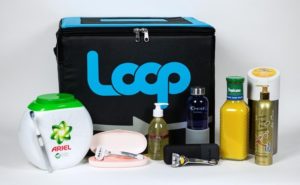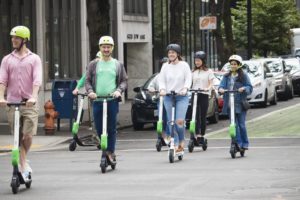I see many stories about digital transformation (DX) projects delivering less than expected, or for more effort, more culture change needed, or causing unexpected organisation disruption, or stretching in-place leadership capability. All of this is true, but is that the right focus? While the term can apply to a range of impacts – from implementing new technology for process improvement through to redefining the way business operates to meet changing or new customer needs – the gains usually arrive some time after deployment, ideally multiple deployments to a programme, and also usually after feedback that changes what’s delivered to end-customers.
One key success factor: Start with a clear vision, one that gives people clear direction
I don’t have a prescription or a toolkit to promote. Here I just illustrate with 3 examples of the way some organisations are approaching big changes, and I think relevant that they’re not labelled as DX programmes. They’re really innovation stories with technology as an essential enabler – the way it’s been since computers started processing payrolls.
The examples, all aimed at market disruption to some extent:
- TerraCycle aims to disrupt part of it’s own recycling business
- An industry-wide collaboration uses blockchain as basis for a food traceability system
- Lime’s e-scooter market development goes like a rocket
TerraCycle and the Loop initiative – Package-reuse-as-a-Service
This company is well known as a large global recycling business, with 21 country operations worldwide for reprocessing packaging and recyclables. Their next goal is to disrupt the packaging industry with a returnable package system where the product manufacturer owns the package, rather than the end-consumer at present. They have partnered with several major retailers to re-think product packaging, and design a return container  system for multiple re-use of what currently becomes waste.
system for multiple re-use of what currently becomes waste.
CEO & co-founder Tom Szaky sees the packaging that we consumers own once we buy a product as too wasteful. His innovation with Loop is to revert to the manufacturer owning the packaging, making it reusable and long-lasting rather than trash. Tom knows from being 16 years in the business that recycling can’t work for sustainability. Given the amount of petroleum companies invested in plastics and their continued pursuit of plastics growth, it’s pleasing to see the big brands backing the Loop project. That will enure it gets traction and hopefully reduce the amount of plastic packaging to as near zero as possible.
More here: How Tom Szaky got Unilever, P&G, Nestle, Mars and more to redesign their packaging
Trackback and blockchain product origin authentication
New Zealnd’s flagship Manuka honey has been shipped to China using blockchain to authenticate to the end consumer the validity of delivered product of origin.
Blockchain used to authenticate exported mānuka honey from NZ
 The project was partnership with major industry players including our Ministry for Primary Industries, our QA authority AsureQuality, the honey supplier, software company Trackback and ANZ Bank – a true end-to-end rethink. That’s what is needed for end-to-end supply chain transparency.
The project was partnership with major industry players including our Ministry for Primary Industries, our QA authority AsureQuality, the honey supplier, software company Trackback and ANZ Bank – a true end-to-end rethink. That’s what is needed for end-to-end supply chain transparency.
The developer envisioned a purchase authentication app that blends IoT, scanning, logistics, smart contracts and blockchain for the digital transaction ledger. The system was able to verify all events in the supply chain, as well as evidence of the honey producer’s testing protocol by recording on the blockchain, Customers in China could be certain the product shipped were those packaged in New Zealand.
Developer Trackback is also a member of Centrality, described as “one of the leading, blockchain venture studios in the world, with a growing team of 90 people across Auckland, London, Melbourne, Singapore.”
The Lime e-scooter story – Mobility-as-a-Service
Perhaps it’s no surprise that the green Lime e-scooters have appeared to burst on the scene in the same way Uber did a few years ago. Uber and Alphabet just invested $335 million in Lime — and scooter start-ups are suddenly worth billions. And it’s a capital intensive business, using a digitally-enabled scooter, a software app with IoT, on-board access and tracking, and billing. So what’s being disrupted?
A quote from the video interview (see link below) –
“The scooter startups have not released any information on the average age of their riders, but it would seem to be no accident that they all are zeroing in on urban areas (Austin, Los Angeles, San Diego and Washington, D.C., for example) with large concentrations of millennial residents, a coveted consumer demographic.”
Lime e-scooters video: Lime founder talks to Bloomberg on growth prospects
Most likely some disruption is being felt by cabs and Uber drivers, but mostly where those options aren’t ideal, as in shorter commutes during peak traffic.
No question the target demographic is young adults looking for a short commute, from a few hundred metres up to 2 km or so. Most useful in rush hour when city commutes over those distances are slow and expensive.
Common themes
Looking at what is common to those examples we see a few themes for innovation –
- Rethinking the customer experience, the end-to-end result for the re-focus on customer
- Partnerships that cross usual boundaries to form a more universal delivery or service chain
- Leveraging new tech capability to exploit a real but unmet customer need
- Exploring & developing market potential at global scale
- Keeping as-a-Service thinking high on the storyboard, to develop the ease of adoption
- Critical – investment is essential for both innovation development and market growth
A conclusion – see more than bits
Technology is always evolving, pushing new boundaries and that will continue. While the mobile app capabilities are maturing we’ve only scratched the surface of what’s possible with AI, IoT, robotics, big data etc. The innovation is not in the tech as much as understanding how tech opens new business and market opportunity – transformative.
Achieving that suggests a clear vision keeping these behaviours in sharp focus:
- CX – the customer experience is at the heart of all strategy and decisions. Particularly relevant to the blockchain product delivery example, but applies in every instance.
- Iterative progress – the Agile mindset rules. Nailing the critical requirements means constant involvement from the business and product owners.
- The starting MVP will grow – for Lime scooters the MVP had to be the total value offering, while for the other more software-centric projects the concept could be developed to a proof or pilot level and built on. But, each example required a deep commitment to real innovation, to staying the course for the better vision.
- Continually engage – Good digital transformations can drive business growth. Frequent updating and progress reporting for all stakeholders is essential and helps them keep engaged from clarifying the use cases to readying all those needed for successful deployment. Again an Agile practice which differs from the traditional waterfall approach.





